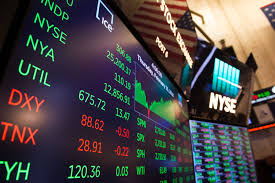The Slump in U.S. Stocks Is Accelerating. These Are the Culprits for the Big Selloff

One of the least celebrated aspects of bull markets is that they are like lush, overgrown forests. Every new record set by stock indexes is that much more foliage that’s ready to burn, should someone throw a match into the landscape.
Now that a decline in U.S. stocks, which began a week ago, is accelerating into a worrisome slump, market observers are wondering where the matchsticks came from. There are two likely culprits: One encouraged by President Trump—an escalating trade war with China—and one that Trump has loudly criticized—the Federal Reserve’s willingness to keep raising interest rates.
On Wednesday, the Dow Jones Industrial Average lost 831 points, or 3.2% of its value. The S&P 500 Index dropped 3.3%, while the tech-heavy Nasdaq Composite was hit hardest of all, falling 4.1%. Since the market’s close one week ago, the Dow is down 4.3%, the S&P is down 4.5% and the Nasdaq has fallen 7%.
That’s hardly the stuff of bear markets, which are usually declared once an asset loses 20% of its peak value. But it has left some investors on edge because U.S. stocks have enjoyed low volatility since March. And also because trade wars and higher interest rates are two threats to the stock market that can not only endure for years, but can escalate over time.
Now add in the fact that the bull market in U.S. stocks is well into its ninth year, the absence of major selloffs for the past several months, and the complacency that comes with week after week of record highs, and you have a market that is poised to stumble blindly into a tripwire. Whether the declines continue in coming days remains to be seen—and will largely be determined by what happens in the bond market and on trade fronts.
The Fed has been raising interest rates to guard against the risk of inflation, should wages and prices rise further. One important gauge of inflation, the consumer price index, will be reported Thursday. The CPI rose a non-threatening 0.2% in August, but a higher number in September could leave bond investors preparing for more rate hikes from the Fed.
Meanwhile, the trade war shows little sign of being resolved any time soon. In fact, it looks to be broadening into a currency dispute as well, with some market observers noting that the Chinese renminbi has risen 10% recently, just enough to offset the 10% tariffs that the Trump administration imposed on many Chinese imports. To some in the White House, that reportedly smacks of manipulation.
Treasury Secretary Steven Mnuchin hasn’t labeled China a currency manipulator, but he did call Wednesday for currency policies to be part of upcoming trade talks with China. “As we look at trade issues there is no question that we want to make sure China is not doing competitive devaluations,” Mnuchin told the Financial Times. “The renminbi has depreciated significantly during the year.… We are going to absolutely want to make sure that as part of any trade understanding we come to that currency has to be part of that.”
Perhaps the hardest and most concerning selloffs have been in the tech sector, with Apple, Microsoft, and Alphabet falling 4% or more. Other tech names were battered harder: Netflix fell 8.3%, Amazon 6.2% and Twitter 8.5%. Many tech companies are relying on China for new customers or low-cost suppliers, and a trade war leaves them at risk.
While the tech industry has led the U.S. market higher this year, it is also one of the most highly valued. Amazon’s price-to-earnings ratio is 139 even after today’s selloff, while Netflix’s PE is 148. That leaves many tech stocks vulnerable to more selling, should bad news continue to rollout in the coming days.

